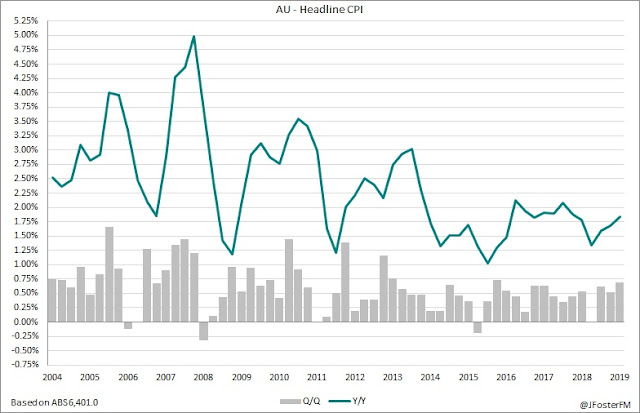Consumer Price Index — Q4 | By the numbers
- Headline CPI increased by 0.69% in Q4 to come in a touch above consensus (0.6%) and firmer than in Q3 (0.52%). Annual CPI lifted from 1.67% to 1.84% against an expected 1.7% rise, reaching its fastest pace since Q3 2018.
- Details for the underlying measures are as follows;
- Trimmed mean inflation increased by 0.43% in the December quarter (expected: 0.4%, prior revised: 0.4%), which saw the annual pace unchanged at 1.57% (expected: 1.5%).
- Weighted median inflation lifted by 0.36% in Q4 (expected: 0.4%, prior 0.36%), with the annual pace easing very slightly from 1.31% to 1.28% (expected: 1.2%).
- The average of the underlying measures was little changed at 0.4% in Q4 (prior: 0.38%) and 1.42%Y/Y (prior: 1.44%Y/Y)
Consumer Price Index — Q4 | The details
Looking into the headline CPI result, Q4's increase of 0.69% was slightly firmer than anticipated and was the strongest quarterly rise since Q3 2016. As an overview, the main contributors to the quarterly outcome were from alcohol and tobacco (+0.27ppt), food and non-alcoholic beverages (+0.24ppt) and transport (+0.18ppt). Groups subtracting from inflation in Q4 were; furnishings, household equipment and services (-0.03ppt), communication (-0.02ppt), health (-0.02ppt) and clothing and footwear (-0.01ppt).
From another perspective, the next chart shows the price changes recorded by each group in Q4 and for the year.
Alcohol and tobacco prices jumped by 3.0% in Q4 to be up by 6.5% over the year. This was predominantly driven by an 8.4% rise in tobacco prices in the quarter (14.0%yr) linked with the remainder of the annual tobacco excise tax increase, effective from the final month of Q3. Alcohol prices declined by 0.7% in Q4 but were up by 1.4% year on year.
The transport group saw prices firm by 1.5% in Q4 and rise by 2.8% over the year. The key factor was a 4.4% rise in petrol prices (2.9%yr) following increases in global oil prices and a softer Australian dollar. Moderating this increase, new vehicle costs declined by 0.6% in the quarter (3.4%yr).
Food and non-alcoholic beverage prices lifted by 1.3% in Q4 and by 2.6% in annual terms. Most notably, fruit prices spiked by 6.8% in the quarter, while beef and veal prices lifted by 2.9%, with both being affected by drought conditions. The ABS reports that meat prices have also been driven up by strong global demand and by the spread of African Swine Flu in Asia. Takeaway meal and restaurant prices rose by 1.0% in Q4.
The recreation and culture group lifted by 0.9% in the quarter and by 1.5% over the year. Q4's increase was driven mainly by a 7.3% rise in domestic holiday travel associated with the peak holiday period, suggesting that bushfire-related impacts have not yet been captured. On the other hand, international travel prices fell by 2.9% in the quarter coinciding with the off-peak seasons in Europe and the US.
Insurance and financial services costs were up by 0.4% in the quarter but were up only modestly through the year (0.7%).
The key housing group continued its recent weakness, with prices virtually flat in Q4 (0.1%) and over the year (0.2%). In the quarter, rents were flat (0.2%yr), while new dwelling costs lifted by 0.4% (-0.1%yr). Utility prices fell by 0.3%, due mainly to regulatory changes that have resulted in lower electricity prices.
Education costs were little changed in Q4 (0.1%), with the annual pace at 2.9% reflecting rises from secondary education (4.2%) and primary education (2.9%).
The largest fall in prices was recorded by the communication group that declined by 1.0% in Q4 and by -3.8% over the year. Strong competition between service providers continues to result in cheaper prices for consumers.
Health prices slid by 0.3% in Q4 but were up by 3.2% over the year. Q4's decline reflected a larger number of consumers becoming eligible for subsidies available under the federal government's Pharmaceutical Benefits Scheme, which reduces out-of-pocket costs.
Clothing and footwear prices fell by 0.3% in Q4, though were up modestly in annual terms (1.4%). Q4's decline likely reflects widescale discounting by retailers over the Black Friday promotional period and this competition moderates the impact of the pass-through to prices from a lower Australian dollar.
The furnishings, household equipment and services group fell by 0.3% in the quarter to be up by 1.1% on the year. Discounting associated with Black Friday weighed on household textiles (-3.7%) and furniture (-1.4%) prices during the quarter. However, child care prices lifted by 1.5% in Q4 and are up strongly (7.2%) over the year.
Overall, the breakdown of inflation continues to show that non-tradables (influenced by domestic factors) are the dominant source of inflation pressures (1.98%yr), though tradables inflation (reflecting global influences) has been on the rise in recent quarters (1.66%yr) reflecting the pass-through from a declining Australian dollar.
Consumer Price Index — Q4 | Insights
Inflation in Australia continues to remain steady and well below the RBA's 2-3% target range. The December quarter's results on the headline measure at 0.7%q/q and 1.8%Y/Y were slightly stronger than the consensus forecasts but a touch under the RBA's forecast from November's quarterly statement (1.9%Y/Y). The Bank's preferred trimmed mean measure matched consensus in Q4 at 0.4% but surprised to the upside in annual terms at 1.6%, however this was in line with the RBA's expectations. Overall, there looks to be little in today's report that would greatly alter the Bank's assessment of the inflationary environment. As such, markets have responded by further lowering pricing for a February rate cut to below 10%; this after last week's stronger-than-expected employment report prompted expectations to fall from around a 60% chance to around 20%.






